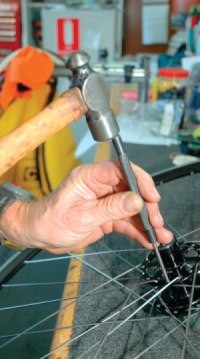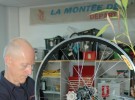Building the Wheels
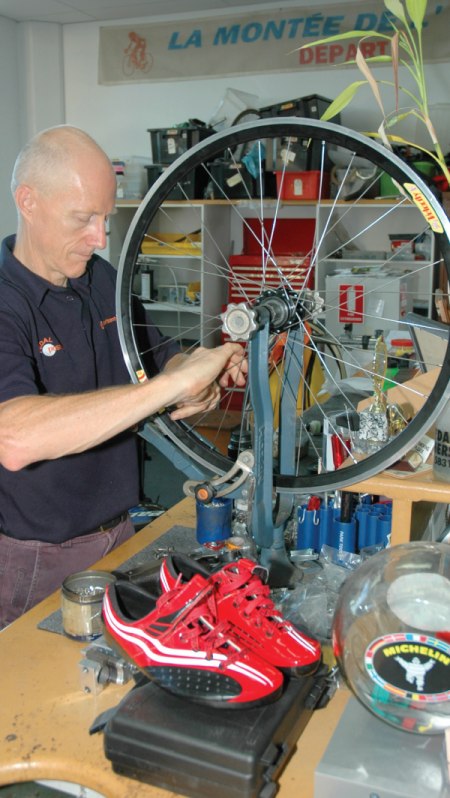 The answer to this question is contained in a seminal book named:The Bicycle Wheel by Jobst (pronounced Yopst) Brandt. Brandt built similar wheels with the only difference being cross pattern. He built radial, one cross, two cross, three cross and four cross versions and then tested the lateral deflection of each when held in a fixture with a fixed load applied. What he found is that radial and one cross pattern wheels have the least resistance to lateral loads and there is no discernible difference between two cross, three cross and four cross, though all are noticeably better than radial or one cross. I know what you’re thinking. You are thinking, why are spokes crossed at all? The answer is so that each spoke contacts one another. For instance a three cross wheel crosses three other spokes on its journey from hub flange to rim. It passes over the first two of these spokes and under the third pressing against it. This allows two things. Firstly transient stresses, like hitting a bump or a pothole, are spread over as many spokes as possible because each spoke is pressed against another. Secondly, while it is possible to build an adequate radially laced front wheel or the non drive side of a rear wheel, it isn’t possible to do this reliably on the drive side of a conventional hand built rear wheel. When the rider applies force to the pedals the torque load on the pedals is transferred by the chain to the rear cogs. This causes the spokes facing rearwards relative to direction of travel on the rear wheel to increase in tension. These are called pulling or dynamic spokes. It also causes the spokes facing forwards in relation to direction of travel to decrease in tension by the same amount.
The answer to this question is contained in a seminal book named:The Bicycle Wheel by Jobst (pronounced Yopst) Brandt. Brandt built similar wheels with the only difference being cross pattern. He built radial, one cross, two cross, three cross and four cross versions and then tested the lateral deflection of each when held in a fixture with a fixed load applied. What he found is that radial and one cross pattern wheels have the least resistance to lateral loads and there is no discernible difference between two cross, three cross and four cross, though all are noticeably better than radial or one cross. I know what you’re thinking. You are thinking, why are spokes crossed at all? The answer is so that each spoke contacts one another. For instance a three cross wheel crosses three other spokes on its journey from hub flange to rim. It passes over the first two of these spokes and under the third pressing against it. This allows two things. Firstly transient stresses, like hitting a bump or a pothole, are spread over as many spokes as possible because each spoke is pressed against another. Secondly, while it is possible to build an adequate radially laced front wheel or the non drive side of a rear wheel, it isn’t possible to do this reliably on the drive side of a conventional hand built rear wheel. When the rider applies force to the pedals the torque load on the pedals is transferred by the chain to the rear cogs. This causes the spokes facing rearwards relative to direction of travel on the rear wheel to increase in tension. These are called pulling or dynamic spokes. It also causes the spokes facing forwards in relation to direction of travel to decrease in tension by the same amount.Hand tools Steve uses for the job. (Below) A calculator with spoke lengths programmed. Spokes, Loctite 222, DT Swiss Dogleg Screwdriver, DT Swiss nipple gripping driver, spoke keys from DT Swiss and Sapim, spoke punch, hammer, nipples, digital verniers for measuring flange and hub length, spoke ruler for checking spoke length.
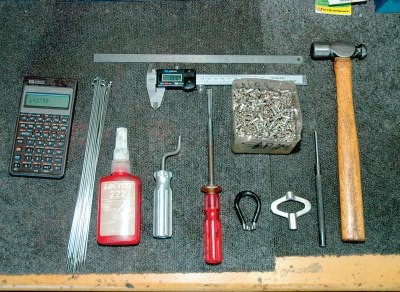 In the presence of water, the spoke and nipple will corrode together making any subsequent truing required during the life of the wheel, much more difficult than need be. Some people use oil or grease instead of 222, but oil and grease dry up and dissipate over time while 222 doesn’t. Loctite 245 works well too, but 222 has a property that 245 doesn’t. Any subsequent turning of the nipple during wheel truing at some future time will break the bond of 245 but will not affect 222. There are proprietary compounds from spoke manufacturers available too, but all are more expensive or work less well than 222 Loctite. I won’t waste space by describing the lacing process because it is simple and anyone can learn how with a little practice.
In the presence of water, the spoke and nipple will corrode together making any subsequent truing required during the life of the wheel, much more difficult than need be. Some people use oil or grease instead of 222, but oil and grease dry up and dissipate over time while 222 doesn’t. Loctite 245 works well too, but 222 has a property that 245 doesn’t. Any subsequent turning of the nipple during wheel truing at some future time will break the bond of 245 but will not affect 222. There are proprietary compounds from spoke manufacturers available too, but all are more expensive or work less well than 222 Loctite. I won’t waste space by describing the lacing process because it is simple and anyone can learn how with a little practice. 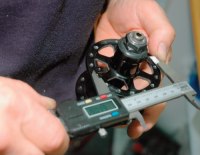


Ensuring the spokes are seated correctly in the hub:
